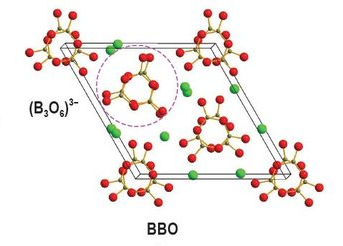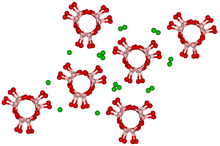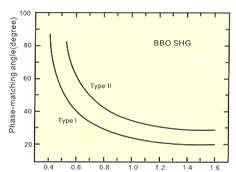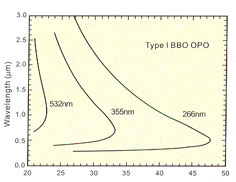Home > NLO Crystals >> BBO
BBO Crystal & its Applications
β-Barium borate(BBO) is a premier non-linear optical (NLO) crystal that was discovered in the 1980s. The BBO crystal is distinguished by its excellent transmittance across ultraviolet to near-infrared wavelengths, a large effective nonlinear coefficient, high damage thresholds, exceptional thermal stability, and other notable physical properties. BBO crystals are widely used in second harmonic generation (SHG), sum frequency generation (SFG), optical parametric oscillation/optical parametric amplification (OPO/OPA), and electro-optic modulation applications, particularly for high-power lasers such as Nd:YAG and Ti:sapphire ultrafast lasers.
Article Contents:
2. Properties of BBO crystal
3. Comparing of BBO to LBO KTP KDP/KD*P crystals
4. Applications of BBO crystal
5. Manufacture of BBO crystal
6. Order BBO crystal
1. Historical background of BBO crystal
BBO crystal was first discovered in 1979 by Chen Chuangtian and his team member at the Fujian Institute of Research on the Structure of Matter, Chinese Academy of Sciences. In 1983 it was grown to a practical size and tested by Chen's team member. Before that, scientist used KDP or ADP crystal for SHG, THG, FHG of ns pulse Nd:YAG laser. KDP and ADP has good UV transmission and high damage threshold. But KDP and ADP are prone to deliquescence; special protection is needed to avoid crystal damage. Additionally, the conversion efficiency is low due to KDP's relatively small NLO Coefficients. During that period, KTP was also available, however, its application is constrained to medium power Nd:YAG laser's SHG, because of issues such as UV absorption, a relatively low damage threshold, and limitations in phase matching. The introduction of BBO crystal marked a significant advancement for photonics research and industry. BBO features substantially higher NLO coefficients: d11=5.8*d33(KDP), superior UV-NIR transmission and higher damage threshold. Since then, BBO became the best NLO crystal. Until recently, BBO remains one of the best NLO crystals and the preferred choice for NLO applications.


Barium borate exists in three major crystalline forms: alpha, beta, and gamma. The low-temperature beta phase converts into the alpha phase upon heating to 925 °C. β-Barium borate (BBO) differs from the α form by the positions of the barium ions within the crystal. Both phases are birefringent, however the α phase possesses centric symmetry and thus does not have the same nonlinear properties as the β phase. Gamma barium borate, γ-BaB2O4, discovered recently, was produced by heating beta barium borate 900 °C under 3 GPa of pressure. It was found to have a monoclinic crystal structure.
2. Properties of BBO crystal
Crystal Structure:
Rhombohedral, hR126, space group R3c, No. 161Lattice Parameter:
a=b=12.532Å c=12.717Å Z=6Melting point:
~1095 °CMohs Hardness:
4Density:
3.85g/cm3Thermal Conductivity:
1.2W/m/K(⊥c): 1.6W/m/K(//c)Thermal Expansion:
a11=4x10-6/K; a33=36x10-6/Khygroscopic:
NoTransparency Range:
190-3500nmSHG Phase Matchable Range:
409.6-3500nm(Type I) 525-3500nm(Type II)
Thermo-Optic Coefficients:
dno/dT=-16.6x10-6, dne/dT=-9.3x10-6Absorption Coefficients:
0.1%/cm@1064nm 1%/cm@532nmAngle Acceptance:
0.8mrad-cm(Type I, SHG@1064nm)1.27mrad-cm(Type II, SHG@1064nm)
Temperature Acceptance:
55°C-cmSpectral Acceptance:
1.1nm-cmWalk-off Angle:
2.7°(Type I SHG@1064nm)3.2°(Type II SHG@1064nm)
NLO Coefficients:
deff(I)=d31sin(θ)+(d11cos(φ)-d22sin(3φ))cos(θ)
deff(II)=(d11sin(3φ)+d22cos(3φ))cos2(θ)
Non-vanished NLO susceptibilities
:d11=5.8xd36(KDP) d31=0.05xd11 d22<0.05xd11
BBO Sellmeier Equations: (λ in µm )
no2=2.7359+0.01878 /(λ2-0.01822)-0.01354λ2
ne2=2.3753+0.01224/(λ2-0.01667)-0.01516λ2
Electro-optic coefficients:
r22=2.7pm/VHalf-wave voltage:
7KV (at 1064nm,3*3*20mm3)Resistivity:
>1011 ohm-cm3. Comparing BBO crystal to LBO KTP KDP/KD*P
Comparing BBO to other NLO crystals including LBO, KTP, KDP/KD*P, BBO has significantly advantages.
Advantages of BBO crystal:
- An extremely wide transmission wavelength range of 190-3500nm. Comparing to KDP, LBO, BBO has better NIR transmission; Comparing to KTP, BBO has beter UV transmission.
- A larger effective nonlinear coefficient, d11=5.8xd36(KDP). BBO's nonlinear coefficient is larger than KDP and LBO except KTP.
- An extremely wide phase matching wavelength range of 409.6-3500nm (Type I) and 525-3500nm (Type II). BBO is phase matchable in all transparent wavelength range. This is attributed to the strong birefringence of BBO.
- An extremely low absorption coefficient of 0.1%/cm@1064nm;
- An extremely high optical damage threshold, >10 GW/cm2 at 1064 nm, 1 ns pulse;
- Excellent thermal stability;
- Non-hygroscopic
- High optical homogeneity, which helps improve the stability of laser output power;
- A weaker piezoelectric ringing effect, providing a higher extinction ratio for electro-optic modulation;
- Good mechanical properties, allowing for the production of <0.1mm thin BBO plate to minimize group velocity mismatch.
BBO's disadvantages:
- Relatively large walk-off, larger than that of LBO, KTP.
- Relatively small acceptance angle, smaller than that of LBO, KTP.
| NLO crystals | BBO | LBO | KTP | KDP |
|---|---|---|---|---|
| Effective NLO Coefficient ×d36(KDP, 0.44pm/V) | 5.3 Type I | 2.69 | 8.3 | 0.6 |
| Angle Acceptance(mrad-cm) | 0.8 Type I 1.27 Type II | 6.54 Type I 15.27 Type II 52 Type I NCPM | 14.2 | KDP |
| Temperature Acceptance(°C-cm) | 55 | 4.7 Type I 7.5 Type II | 24 | KDP |
| Spectral Acceptance(nm-cm) | 1.1 | 1.0 Type I 1.3 type II | 0.56 | KDP |
| Walk-off Angle (degree) | 2.7 Type I 3.2 Type II | 0.60 Type I 0.12 Type II 0 NCPM | 0.55 | 1.6 |
| Damage Threshold GW/cm2, 1ns | 10 | 19 | 4.6 | 8.4 |
4. Applications of BBO crystal
BBO crystals are the preferred choice for nonlinear optical applications. BBO crystals are widely used in:
1) SHG/THG/FHG and 5th harmonic generation of Nd:YAG Laser
- BBO is one of the best NLO crystal for frequency doubling, tripling and quadrupling of high power acousto-optic, electro-optic Q-switched and mode-locked Nd:YAG or Nd:YLF lasers; BBO has higher effective nonlinear coefficient than KDP, d11=5.8xd36(KDP); and higher damage threshold than KTP; BBO was the only commercially available non-linear optical crystal for 5th harmonic generation (1064nm + 266nm-->213nm and 532nm + 355nm-->213nm) of Nd:YAG lasers and still is one of the best. Conversion efficiencies of more than 80% for SHG, 70% for THG, 60% for 4HG, and 300mW output at 213nm have been reported.| Type I BBO | SHG | THG | 4HG | 5HG |
|---|---|---|---|---|
| Effective NLO Coefficient (*d36 (KDP)) | 5.3 | 4.9 | 3.8 | 3.4 |
| Acceptance Angle (mrad-cm) | 1.0 | 0.5 | 0.3 | 0.2 |
| Walk-off Angle (degree) | 3.2 | 4.1 | 4.9 | 5.5 |

2) SHG THG FHG of ultra-fast Ti:Sapphire Laser
- BBO is a prime NLO crystal for frequency doubling, tripling, and quadrupling of ultra-fast Ti:Sapphire Laser. By using a thin BBO NLO crystal, UV laser as short as 6fs can be generated by frequency doubling, tripling an ultra-fast Ti:Sapphire Laser.3) SHG of Dye Lasers
- Using a BBO NLO crystal, tunable UV output from 205-310nm can be generated by frequency-doubling an Excimer Laser pumped Dye Laser. BBO conversion efficiency is 4-6 times higher than that of ADP NLO crystal.4) SHG of Ar+ Laser
- By intracavity frequency doubling an Ar+ laser, 36 lines of deep UV laser ranging from 228.9nm to 257.2nm can be generated with a Brewster-angle-cut BBO NLO crystal.
5) OPO/OPA
- BBO's OPO and OPA are powerful tools for generating widely tunable laser from UV to IR. 266nm, 355nm and 532nm pumped BBO's OPO/OPA are widely used in research. For example, with 40mJ 75ps 532nm pump, an OPO output ranging from 680nm to 2400nm with the peak power of 1.6MW and up to 30% energy conversion efficiency was obtained in a 7.2mm long type I BBO NLO crystal.6) E-O application
- BBO has much higher damage threshold than KD*P or LiNbO3 NLO crystal. More than 80W output power and 50KHz repetition rate was reached by using BBO NLO crystal and Nd:YVO4 crystal as gain media. At 5KHz, BBO Q-switch get pulse width as short as 6.4ns,and energy of 5.7mJ or peak power of 900KW. BBO has advantages over the commercial A-O Q-switch, including a very short pulse, high beam quality and compact size. However, BBO has a relative small E-O coefficient, the Half-wave voltage is high (7KV at 1064nm,3x3x20mm3). Using longer or thinner BBO crystal can reduce the voltage requirement.5. Manufacture of BBO crystal
Growth of BBO crystal
BBO crystal was first grown by using the flux method. The initial synthesis involved barium borate through the reaction of an aqueous solution of boric acid with barium hydroxide. This was followed by calcination at approximately 600–800 °C to completely convert the powder to the β form. Finally, NaF-NaCl was added as a flux to facilitate the growth of the BBO crystal.
The melting point of pure BaB2O4 is approximately 1095 °C. However, the low-temperature beta phase of BaB2O4 undergoes a conversion to the alpha phase when heated to 925 degrees Celsius. The addition of NaF-NaCl results in a decrease in the melting point, which ranges from 770 to 870 °C, depending on the ratio of NaF-NaCl to BaB2O4. Crystal growth utilizing the flux method can take several weeks to several months. Additionally, other techniques, such as the Czochralski (CZ) method and Metal-Organic Chemical Vapor Deposition (MOCVD), have also been documented.
BBO crystal orientation and cutting
The BBO crystal blank, which is grown along C-axis, requires cutting to specific orientation based on its intended applications. The precise orientation is measured by X-ray crystal orientation instrument. Following the orientation marking, the blank is cut with a crystal cutting machine.
Grinding and Polishing
The BBO crystal is first finely ground with CeO2 on a glass or iron plate, then it undergoes hand polishing. Due to the relatively soft nature of the BBO crystal, it is essential to exercise special care, including maintaining a suitable temperature and ensuring a dry environment. Additionally, the selection of the appropriate polishing agent is vital for achieving surfaces of high quality.
Coating
The BBO crystal is finally coated in high-vacuum chamber.
Types of coating commonly used for BBO:
Single layer MgF2 coating, also call P-coating;
V-coating(V-type anti-reflection coating);
Dual-band AR coating;
Multi-layer broadband AR coating;
Gold electrode coating;
HR coating for BBO crystal is difficult and not recommended.
Coating machine used can be:
electron beam-induced deposition(EBID);
ion-beam-induced deposition (IBID)
Inspection
Finially BBO crystal is inspected before shipping. This include dimensions measure, visual inpection for defect; Zygo interferometer measurement for flatness, wavefront distortion, parallelism; laser scattering for inside material defect; coating durability, spectrometer measurement for reflection.
General specifications of BBO Crystal
Dimension Tolerance:
+0/-0.1mm(WxH), +/-0.1mm thicknessSurface Quality:
10-5 Scratch-digFlatness:
λ/10 @633nmChamfer:
0.1mm@45deg.Clear Aperture:
Central 90% of DiameterParallelism:
<10 arc secondsPerpendicular:
<10 arc minutesOrientation Angle:
+/-0.5deg.Damage Threshold:
5GW/cm2 @1064nm 10ns, 25GW/cm2 @800nm 10fsCoating:
Dual wavelength AR coating:
R<0.2%@ω & R<0.5%@2ωP-coating:
R<0.7% at central wavelength. Durability MIL-M-13508, MIL-C-675C, MIL-C-14806, moderate abrasionBBO Crystal Cleaning Method:
1:1 of high-purity alcohol and ether on soft silk6. Order BBO crystal
Most BBO crystals are custom-made, although Optocity does have some BBO crystals in stock. Excluding BBO crystal growth, the processing from oriented cutting to coating typically takes about 4 weeks. So it's better plan ahead if you need BBO crystal.
In stock availability may vary from time to time, please check our sales for detail.
Commonly used BBO crystals
i. BBO Crystal for Nd:YAG Laser
ii. BBO Crystal for Ti:Sapphire
iii. BBO Crystal for Yb:YAG, Dye Laser, Ar+ Laser
iv. BBO Crystal for OPO/OPA
v. BBO Crystal for E-O application
Request BBO crystal for Quote
< Previous Back to Top Next >